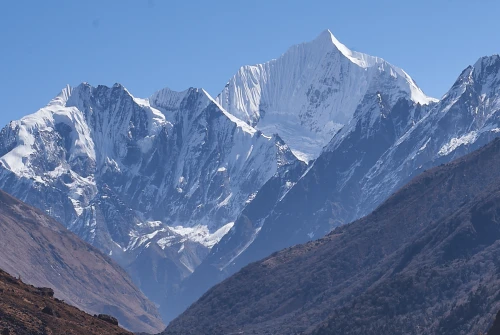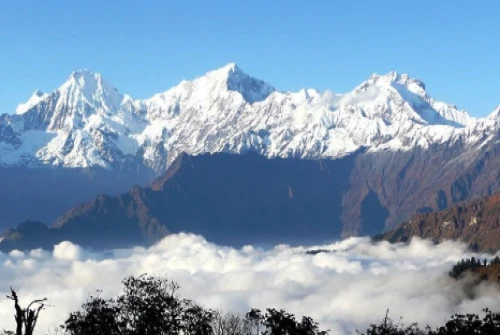Langtang Valley Trek Overview
The Langtang Valley Trek is one of Nepal’s most iconic and captivating trekking adventures. Located just a short distance from Kathmandu, this 10 days journey takes you through diverse landscapes, picturesque villages, and offers spectacular views of the Himalayan mountain range. The trek is ideal for those seeking a serene and immersive experience, away from the crowds of more popular destinations like the Everest Base Camp or Annapurna Circuit.
Langtang Valley is known for its breathtaking scenic beauty, rich cultural heritage, and incredible wildlife. The trek takes you through subtropical forests, past pristine waterfalls, and up into alpine meadows surrounded by towering peaks. The route offers exceptional panoramic views of majestic mountains like Langtang Lirung (7,227m), Dorje Lakpa, and Yala Peak, making it a dream destination for photographers and nature lovers alike.
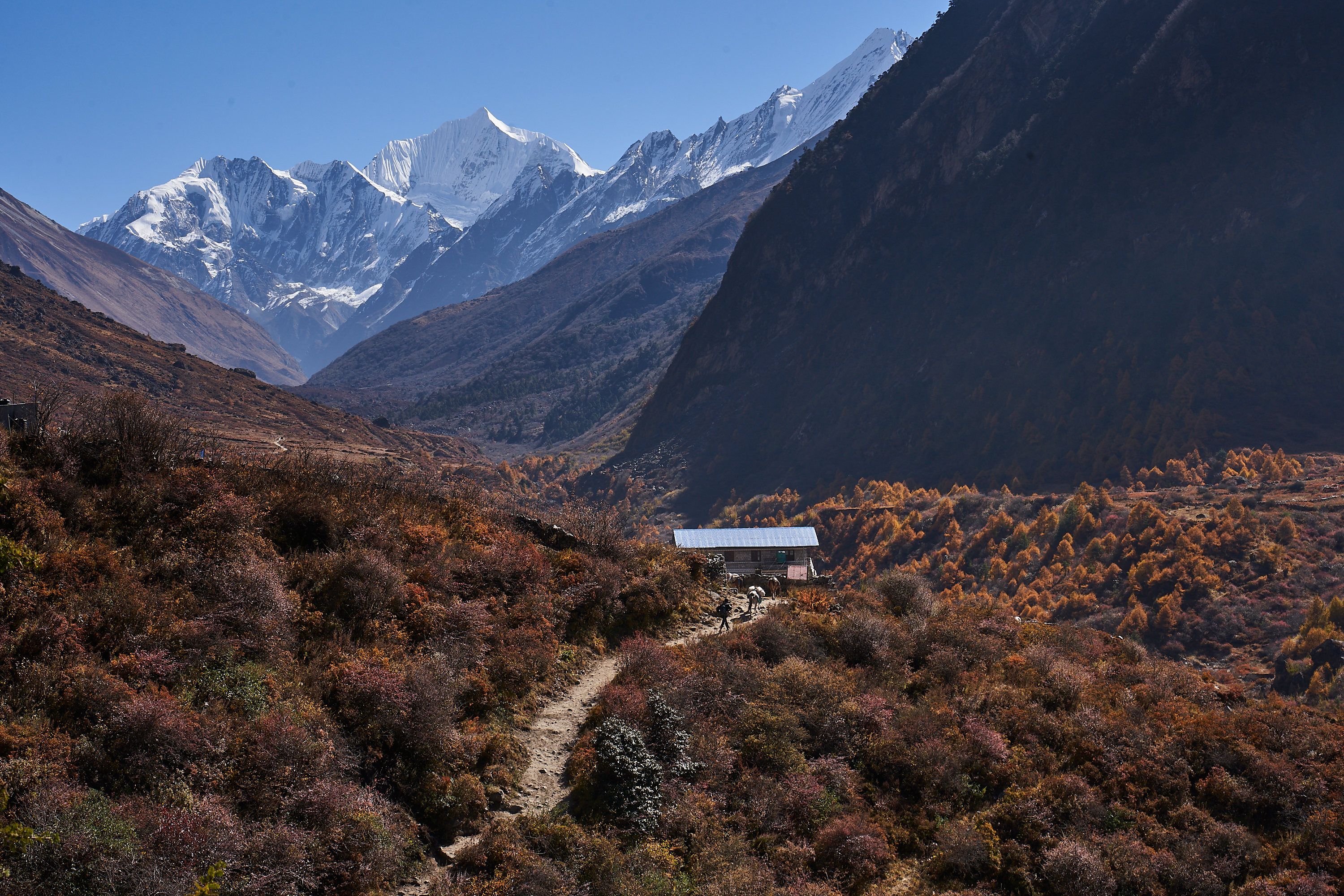
Summary of the Langtang Valley Trek Itinerary
The Langtang Valley Trek begins with a scenic drive from Kathmandu to Syabrubesi, a small village approximately seven hours away. From Syabrubesi, the trek officially starts, taking you into the heart of Langtang National Park. As you follow the Langtang River, you’ll pass through beautiful green forests and remote villages before reaching the Lama Hotel, where you’ll spend the night.
On the second day, you continue your ascent to Langtang Village, where you’ll be greeted by stunning views of Langtang Lirung (7,227 meters). The area is known for its picturesque meadows where yaks, horses, and donkeys graze peacefully. You’ll also pass through camps set up by local nomads. Langtang Village, which was devastated by a landslide during the 2015 earthquake, has since been rebuilt and offers a range of accommodation and food options.
The following day, you head to Kyanjin Gumba, a traditional Tibetan Buddhist monastery. From here, you can enjoy panoramic views of surrounding peaks like Ganchenpo Ri and Langsisha Ri. You’ll spend two nights in Kyanjin Gumba to acclimatize to the altitude. The next day, you’ll embark on a day hike to Kyanjin Ri or Tserko Ri. These hikes offer breathtaking views of the surrounding glaciers, lakes, and mountain ranges, providing one of the most memorable moments of the trek.
After your acclimatization hikes, you begin your descent, retracing your steps back to Lama Hotel. Along the way, you’ll continue to immerse yourself in the culture of the Tamang people, who are descendants of Tibetan migrants. Their villages are rich in traditional Tibetan Buddhist practices, and you’ll have the chance to learn about their way of life. The journey back to Lama Hotel offers beautiful views of green hills and lush landscapes.
On the final leg of the trek, you make your way back to Syabrubesi, completing the loop. The trail back provides new perspectives of the Langtang Valley and Langtang National Park, which are perfect for additional photo opportunities. From Syabrubesi, a jeep ride takes you back to Kathmandu, where your adventure concludes.
The Langtang Valley Trek offers a diverse range of landscapes, including subtropical forests, alpine meadows, and high-altitude glaciers, along with a deep cultural experience. It’s a perfect trek for those seeking a less crowded and more authentic Himalayan adventure.
Landmarks to Explore During the Langtang Valley Trek
The Langtang Valley Trek is a captivating journey that takes you through some of Nepal’s most stunning natural landscapes and cultural landmarks. Although often considered one of the underrated trekking in Nepal, Langtang Valley boasts a number of hidden gems that trekkers will surely remember for years to come. Here are some of the must-visit landmarks that you will encounter along the way:
Kyanjin Gompa
Kyanjin Gompa is one of the most significant landmarks of the Langtang Valley Trek. Located at an altitude of 3,830 meters, this ancient Tibetan Buddhist monastery offers trekkers an enriching cultural experience. The gompa, built centuries ago, serves as a spiritual hub for locals and trekkers alike, and it's the perfect place to learn about Tibetan Buddhist traditions and rituals.
The panoramic views of surrounding peaks like Langtang Lirung, Ganchenpo, and Langsisha Ri are awe-inspiring from here. It is a serene spot where trekkers can pause to reflect, and many hikers also use it as a base for short hikes to the higher vantage points like Kyanjin Ri or Tserko Ri.
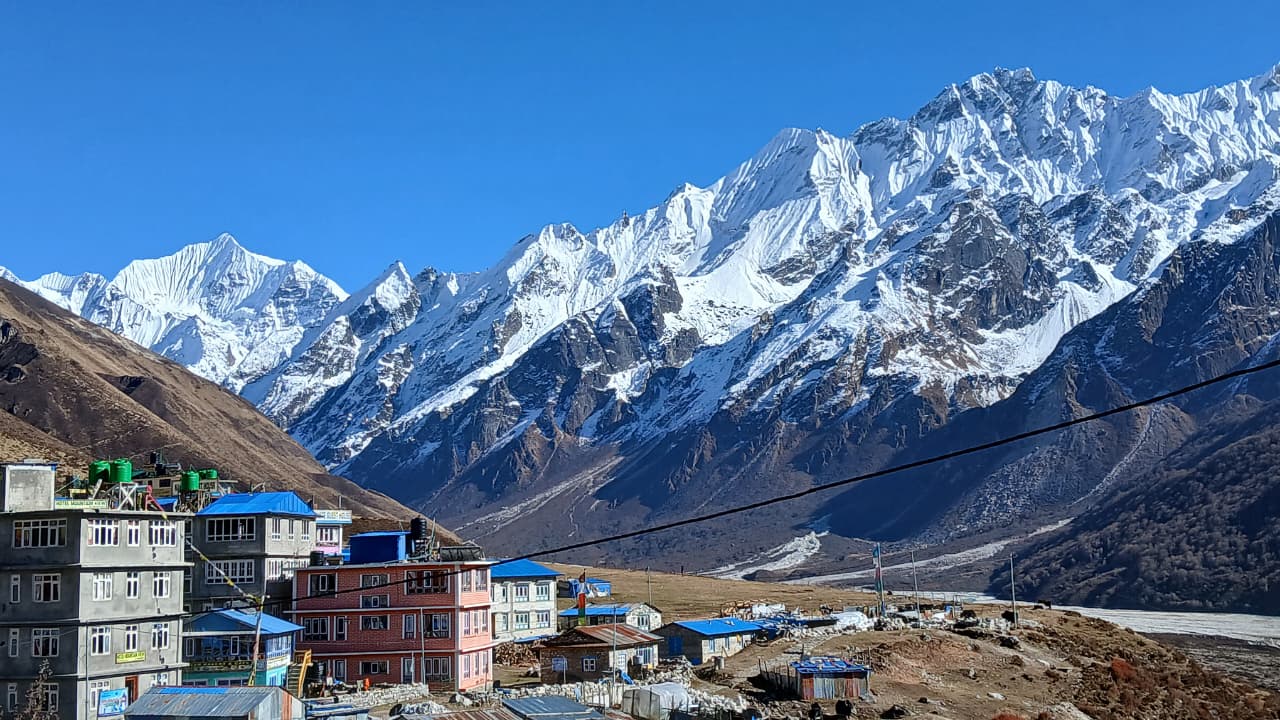
Langtang Glacier
The Langtang Glacier is one of the key attractions in the Langtang Valley, and the region is often referred to as the "Valley of Glaciers". This 18-kilometer-long glacier is an imposing natural feature, and it offers trekkers the opportunity to walk alongside its rugged glacial moraines and ice formations. As you trek towards Kyanjin Gompa and beyond, the proximity to this ancient glacier is a memorable experience. The glacier’s scale, combined with its serene beauty, offers an unforgettable encounter with the raw power of nature.
Gosaikunda Lake
While the Langtang Valley Trek itself is a treasure trove of natural beauty, trekkers who extend their journey to the Gosaikunda Lake will be rewarded with one of the most pristine and sacred landmarks in Nepal. Gosaikunda Lake is nestled in a dramatic alpine setting, surrounded by towering peaks. Situated at 4,380 meters, this clear, blue lake is not only a stunning natural feature but also a deeply significant Hindu and Buddhist pilgrimage site.
The lake is believed to be the home of Lord Shiva, and it attracts hundreds of religious devotees during the full moon festival. If you choose to extend your trek to include Gosaikunda, you’ll not only be treated to scenic beauty but also spiritual serenity.
Tserko Ri and Kyanjin Ri
For panoramic, breathtaking views of the Langtang Valley, Tserko Ri and Kyanjin Ri are two must-visit ridges on the trek. These two peaks are the highest vantage points trekkers can access on this route.
Kyanjin Ri (4,773m) is a popular destination for trekkers looking to catch a 360-degree view of the Langtang Valley and surrounding snow-covered peaks. The hike up to Kyanjin Ri is a moderate challenge but rewards trekkers with an awe-inspiring view of Langtang Lirung, Ganchenpo, and the surrounding glaciers.
Tserko Ri (5,033m) is the highest point in the Langtang Valley trek and offers even more dramatic vistas. From the summit, you’ll get a sweeping view of Langtang Lirung, Gosaikunda Lake, Tamang villages, and the surrounding peaks. The hike to Tserko Ri is a challenging but rewarding ascent, offering trekkers a quiet, peaceful atmosphere as they take in the Himalayan panorama.
Langtang Village
Langtang Village is one of the most iconic landmarks of the trek, both for its stunning setting and its historical significance. Before the 2015 earthquake, the original Langtang Village was located higher up the valley, but it was tragically wiped out by a massive landslide and avalanche triggered by the earthquake. The new Langtang Village, now located further down the valley, has been rebuilt and revitalized.
It offers trekkers the chance to witness how the local community has persevered and rebuilt after such devastation. The village is a charming spot to experience Tamang culture, sample local cuisine, and meet the warm-hearted locals who will likely invite you into their homes.
Lama Hotel
Lama Hotel serves as a key stop along the trail, and it is a significant landmark on the Langtang Valley Trek. Located at an elevation of about 2,480 meters, Lama Hotel is a cozy resting spot after a long day of trekking from Syabrubesi. Nestled within a beautiful forest of oak, rhododendron, and bamboo, the area is peaceful, offering a quiet and tranquil atmosphere. As one of the first overnight stops, Lama Hotel provides trekkers a chance to unwind while enjoying local hospitality and preparing for the higher altitudes ahead.
Bamboo and Rhododendron Forests
As you trek deeper into Langtang Valley, you’ll walk through beautiful bamboo forests and rhododendron groves. These forests not only add to the natural beauty of the trek but also offer an opportunity to spot a variety of wildlife, including the rare red panda and Himalayan tahr. The forests are especially stunning in spring, when the rhododendrons bloom in vibrant colors, creating a picture-perfect setting.
The Langtang Valley Trek is a journey of discovery, offering trekkers not only awe-inspiring Himalayan landscapes but also a chance to explore important cultural landmarks. From the sacred Gosaikunda Lake and the ancient Kyanjin Gompa to the breathtaking views from Tserko Ri and Langtang Glacier, the trek offers a rich mix of natural beauty and cultural heritage.
Whether you are trekking through the resilient Langtang Village, discovering the magic of the forests, or taking in the sweeping mountain views, the landmarks of the Langtang Valley Trek will leave you with lasting memories.
Syabrubesi
The trek begins in Syabrubesi, a small yet vibrant village that serves as the gateway to the Langtang Valley. Located about 7-8 hours' drive from Kathmandu, Syabrubesi is a lively settlement nestled in the foothills of the Himalayas. From here, you start your journey through lush forests, passing through traditional Tamang and Sherpa villages. Syabrubesi offers a glimpse into rural Nepali life and is an ideal spot to get acclimatized before venturing further into the mountains.
Highlights of the Langtang Valley Trek
The Langtang Valley Trek is one of the most captivating and accessible trekking routes in Nepal, offering a perfect blend of breathtaking Himalayan views, rich cultural experiences, diverse ecosystems, and a sense of adventure. Whether you're a seasoned trekker or a first-time visitor to Nepal, the Langtang Valley Trek offers something for everyone.
1. Breathtaking Himalayan Views
From the very first step, the Langtang Valley Trek introduces trekkers to some of the most stunning views of the Himalayas. Snow-capped peaks like Langtang Lirung, Dorje Lakpa, and Shishapangma tower over lush valleys and rushing rivers, creating a dramatic and awe-inspiring backdrop. As you ascend through the valley, the landscape evolves, offering more spectacular views with each step.
The ultimate highlight comes when you reach Kyanjin Ri, a summit at 4,700 meters that rewards you with a 360-degree panoramic view of surrounding peaks, glaciers, and the sprawling valley below. The sheer scale of the Himalayas from this vantage point is nothing short of breathtaking.
2. Rich Tamang Culture
The Langtang Valley is home to the Tamang people, an indigenous group with roots in Tibet. As you trek through the valley, you'll encounter traditional Tamang villages, characterized by stone houses and prayer flags. The valley’s spiritual atmosphere is ever-present, with Buddhist monasteries, chortens, and mani walls (stone walls inscribed with sacred mantras) lining the trails.
The Tamang people’s warm hospitality is legendary, and you'll often be invited into their homes to share a cup of butter tea or a bowl of yak cheese. Witnessing their daily lives, spiritual rituals, and festivals adds a deep cultural layer to the trek, making it not just a physical journey but also a journey into the heart of the local culture.
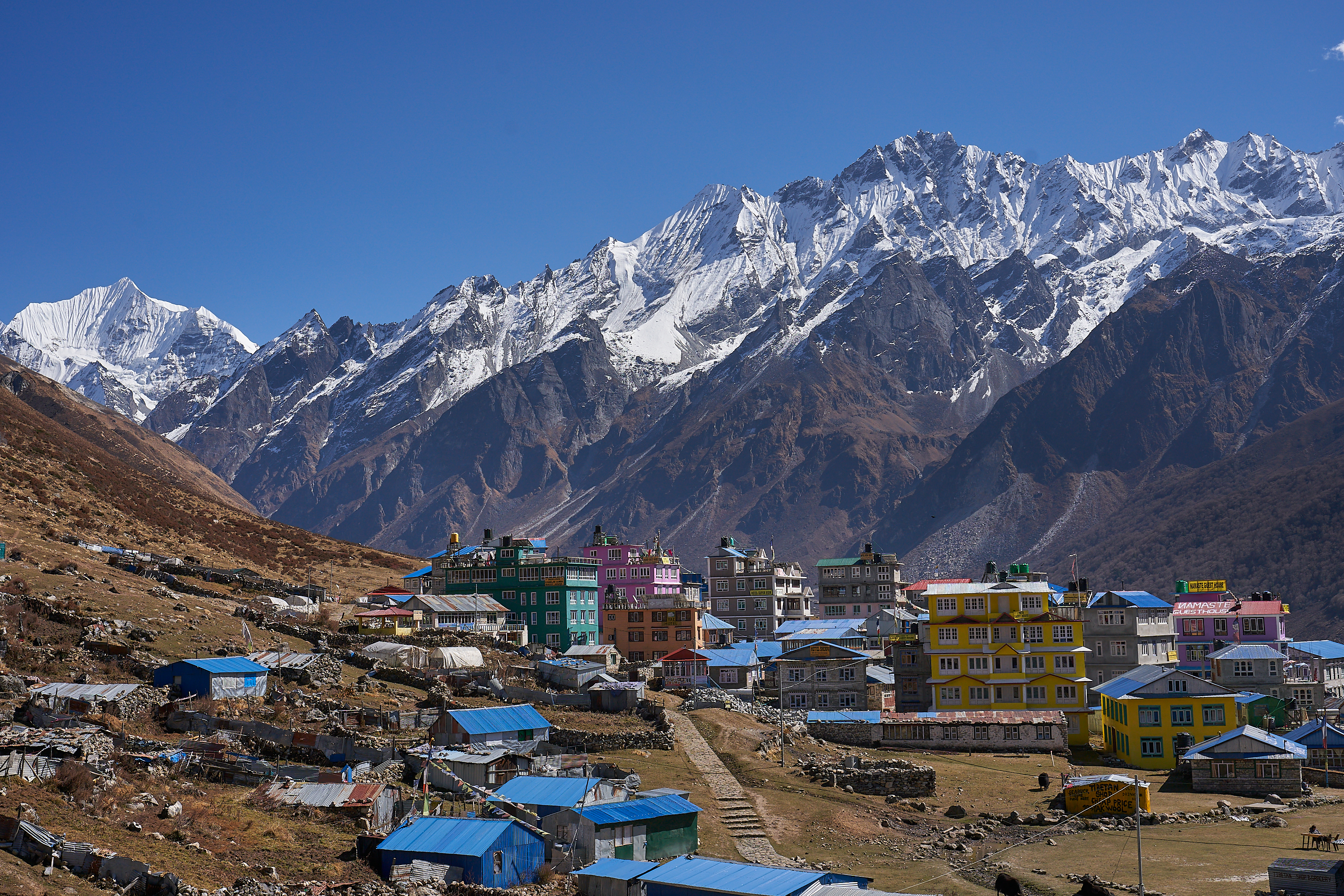
3. Langtang National Park: A Biodiversity Paradise
Langtang Valley lies within the UNESCO-listed Langtang National Park, a haven for wildlife and plant species. The park spans diverse elevations, from dense oak and rhododendron forests in the lower reaches to rugged alpine meadows and glacial lakes at higher elevations.
The trek offers trekkers the chance to spot rare and endangered species such as the red panda, the elusive snow leopard, and the Himalayan black bear. Birdwatchers will also be delighted by sightings of species like the Himalayan griffon vulture and Danphe (the vibrant national bird of Nepal). The ever-changing landscape from lush forests to snow-clad peaks offers something new and enchanting at every turn.
4. Scenic Valleys, Glaciers, and Waterfalls
The Langtang Valley is an extraordinary tapestry of glaciers, rivers, and waterfalls. The trail follows the course of the Langtang River, which flows alongside you for much of the trek, offering picturesque views of cascading waterfalls and pristine streams. The valley’s most striking feature is the Langtang Glacier, a massive ice sheet that trekkers get up close to as they ascend to higher elevations.
Another highlight is the Kyanjin Glacier, located near the Kyanjin Gompa monastery. Its striking blue ice and jagged crevasses make it one of the trek’s most awe-inspiring sites. The changing landscapes, from lush greenery at lower altitudes to the stark beauty of glaciers at higher elevations, create a diverse and visually stunning trekking experience.
5. Kyanjin Gompa: A Spiritual Retreat
At an elevation of 3,800 meters, Kyanjin Gompa is a centuries-old Buddhist monastery that serves as the spiritual heart of the Langtang Valley. Located amidst towering peaks, the monastery offers trekkers a peaceful place for reflection, rest, and spiritual connection. The tranquil atmosphere and panoramic views of surrounding mountains make it the perfect spot to unwind and soak in the serenity of the region.
For those looking to further challenge themselves, a hike to Kyanjin Ri (4,700 meters) offers unparalleled views of the valley and surrounding mountains. Alternatively, a trek to Tsergo Ri (4,985 meters) rewards trekkers with even more spectacular vistas, making it a must-do for those looking to get closer to the Himalayas.
6. Challenging Yet Rewarding Trekking Experience
The Langtang Valley Trek is a moderate-level trek, ideal for those who are reasonably fit but not necessarily experienced mountaineers. The trek lasts between 7 to 10 days, depending on your pace and whether you extend your route to Gosaikunda Lake or other nearby areas.
Although the trek is not as demanding as some of Nepal’s more famous routes like Everest Base Camp or Annapurna Circuit, it still offers a solid challenge. The gradual ascent, combined with changing terrain, keeps things interesting. The reward for your efforts is not only the panoramic views but also the sense of accomplishment that comes from reaching higher altitudes and exploring remote regions.
7. Thrilling Suspension Bridges
One of the most exhilarating parts of the Langtang Valley Trek is crossing the suspended bridges that span the deep ravines carved by the Langtang River. These traditional bridges, often swaying slightly in the breeze, add a sense of adventure to the trek. As you cross these bridges, you’ll enjoy spectacular views of the valley and the wild, rushing waters below an experience that adds an element of thrill to the journey.
8. Delicious Local Cuisine
The trek also offers the opportunity to sample traditional Tamang and Nepali dishes, which are hearty and delicious. Local teahouses along the trail serve dishes like dal bhat (lentil soup with rice), momos (dumplings), and thukpa (noodle soup). The food is prepared fresh, using local ingredients, and provides the energy needed to keep you going on your trek.
In addition, yak cheese is a must-try delicacy in the region, and many trekkers enjoy it with local butter tea, a traditional beverage known for its ability to help with acclimatization at higher altitudes.
9. Optional Extension to Gosaikunda Lake
For trekkers looking to extend their adventure, a visit to Gosaikunda Lake, a sacred high-altitude lake located at 4,380 meters, is an excellent choice. The lake is a revered pilgrimage site for both Hindus and Buddhists and is considered the home of Lord Shiva. The trek to the lake offers spectacular views, and its serene waters, framed by snow-capped peaks, provide a peaceful retreat. The additional trek to Gosaikunda also offers a chance to experience a different side of the Langtang region, with a more rugged and remote feel compared to the main valley.
10. Peaceful and Less Crowded Trails
Unlike the more popular trekking routes in Nepal, such as the Everest or Annapurna regions, Langtang Valley is relatively less crowded, especially during the off-season. The quieter trails allow trekkers to enjoy the natural beauty of the region in peace and solitude. The absence of large crowds also means that you can experience the authentic culture of the Tamang people without the commercialization often found in more tourist-heavy areas.
How the 10-Day Langtang Valley Trek is Different From Other Treks
The 10-Day Langtang Valley Trek offers a unique trekking experience that sets it apart from other popular trails in Nepal. Here are the key factors that make it stand out:
1. Proximity to Kathmandu
Unlike the more remote treks in Nepal, the Langtang Valley Trek is just a 7-hour drive from Kathmandu. For those short on time, this trek allows you to experience the beauty of the Himalayas without traveling far, making it a perfect choice for those with limited vacation days.
2. Unique Tamang Culture
The trek takes you through Tamang villages, where you’ll encounter the rich culture of the Tamang people. From their Tibetan Buddhist traditions to their local festivals, songs, and dances, the Langtang Valley provides an immersive cultural experience you won’t find on other treks.
3. Diverse Landscapes
Despite its shorter duration, the Langtang Valley Trek boasts a diverse range of landscapes. Trekking through rocky ridges, lush forests, glacial moraines, and snow-capped peaks, you’ll experience a variety of terrain that makes this trek a complete adventure in just 10 days.
The Langtang Valley Trek may be short, but it offers a full spectrum of what Nepal trekking has to offer, from culture to nature, all within a convenient distance from the capital.
Why Trek Langtang Valley? A Must-Visit Trek in Nepal
Scenic Beauty & Himalayan Views
The Langtang Valley Trek is a visual feast for nature lovers and photographers. Whether you're trekking through dense forests, alpine meadows, or yak pastures, the views of Langtang Lirung, Dorje Lakpa, and Yala Peak are some of the most stunning you’ll encounter in Nepal. The trek provides an intimate experience of the Himalayas, away from the crowds.
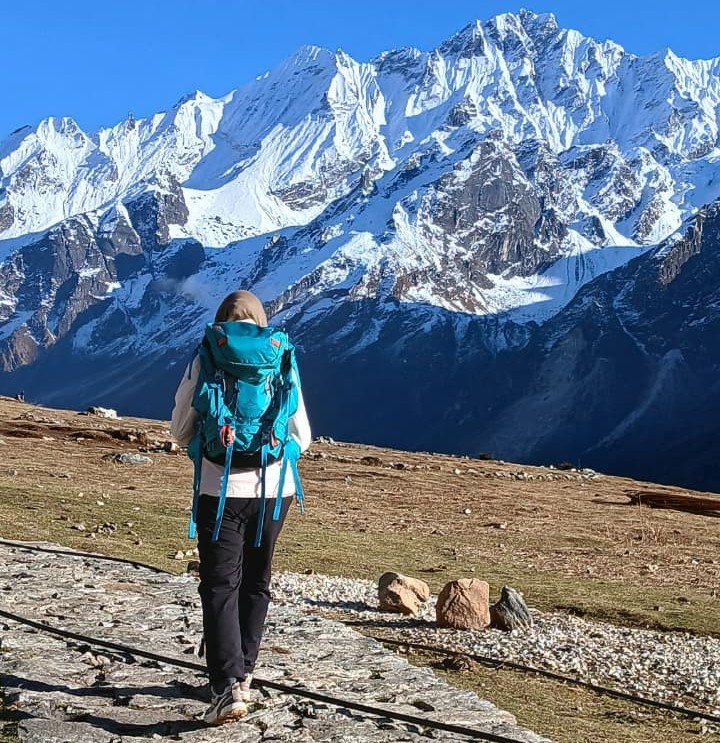
Cultural Immersion
The trek offers a rare chance to experience Tamang culture and Tibetan Buddhism in a way that many other treks in Nepal do not. You’ll pass through ancient villages, where you can observe daily life, interact with locals, and learn about the region’s history and traditions.
Wildlife and Nature
Langtang National Park is a biodiversity hotspot. The park's rich flora and fauna, including red pandas, Himalayan black bears, and snow leopards, make this trek particularly appealing for wildlife enthusiasts. The varied ecosystems of the park, from subtropical forests to alpine meadows, offer diverse flora, including the stunning rhododendron blooms in spring.
Peaceful & Less Crowded
After the 2015 earthquake, Langtang Valley saw fewer trekkers, but now that most of the tea houses have been rebuilt, the region offers a peaceful, uncrowded trekking experience. Compared to other famous treks like Everest or Annapurna, Langtang provides a much more tranquil and intimate experience in the Himalayas.
The Rich and Unique Culture of Langtang Valley: A Deep Dive into Tamang Heritage
The Langtang Valley Trek offers more than just breathtaking landscapes,it provides an immersive cultural experience, particularly through the lives of the Tamang people. With deep ties to Tibetan Buddhism, the Tamang community’s traditions, spiritual practices, and lifestyle give trekkers a unique opportunity to explore Nepal’s rich cultural tapestry.
Tamang People: Guardians of Langtang’s Cultural Heritage
The Tamang people are one of Nepal’s most significant ethnic groups, known for their Tibetan heritage. Their name, derived from the Tibetan words "Ta" (horse) and "Mang" (trader), reflects their historical role as horse traders and their close connection to Tibet. For centuries, they’ve maintained a lifestyle shaped by Buddhism, which is evident in their customs, language, and religious practices.
Tibetan Buddhism and Spirituality in Langtang
Tibetan Buddhism is at the heart of Tamang culture, with Buddhist monasteries, chortens, and prayer wheels dotting the Langtang Valley. The most notable site is Kyanjin Gompa, an ancient monastery that offers trekkers a deeper understanding of Tibetan spiritual life. Buddhist rituals, prayers, and festivals like Losar (Tibetan New Year) are integral to the community’s lifestyle, with mountains considered sacred and revered through prayer flags and ceremonies.
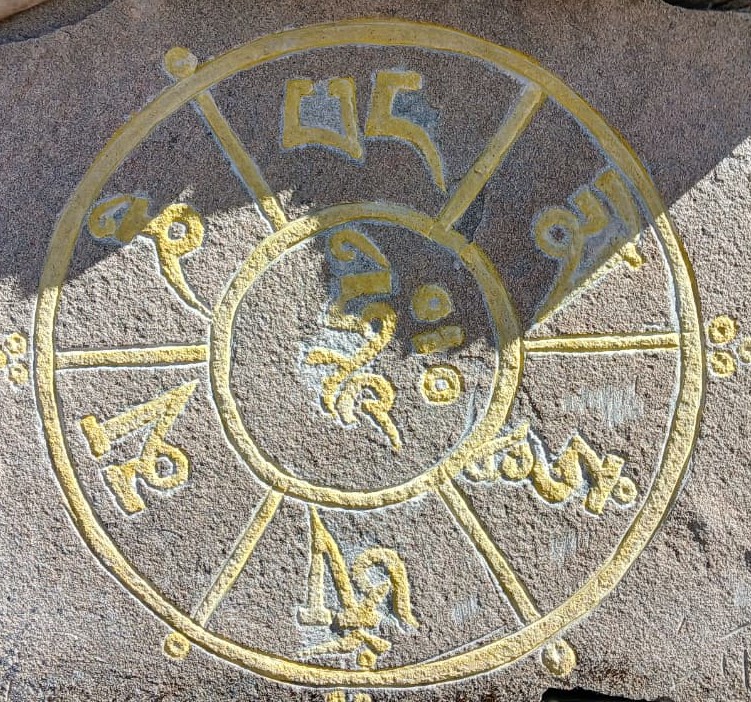
Tamang Cuisine: A Taste of Tradition
Food in Langtang reflects a harmonious blend of Tibetan and Nepalese influences. Staple dishes like Dal Bhat, momos (dumplings), and yak butter tea offer warmth and sustenance during the trek. The yak cheese produced locally is a delicacy that highlights the Tamang's pastoral way of life. Their innovative cuisine, shared with trekkers, is a perfect reflection of their hospitality and cultural pride.
Traditional Tamang Homes and Architecture
The Tamang homes in Langtang Valley, typically built with stone and slate roofs, are designed to withstand the harsh Himalayan climate. These homes are not only practical but often adorned with traditional Tibetan motifs and spiritual symbols, signifying their connection to the land and beliefs. Despite the devastating 2015 earthquake, the Tamang community has shown remarkable resilience, rebuilding homes that continue to preserve their architectural heritage.
Langtang Valley: A Cultural Epicenter
Beyond trekking, Langtang Valley is a cultural hub for the Tamang people. The valley's rich history and the community's reverence for the land are deeply intertwined with Tibetan Buddhism, Hinduism, and Animism. The sacred Gosaikunda Lake, a site of religious significance for both Hindus and Buddhists, is a prime example of how the Tamang people merge spirituality with nature.
Tamang Customs and Traditions
Shamanism also plays a crucial role in Tamang culture, with shamans serving as spiritual healers and intermediaries between the physical and spiritual realms. Visitors can witness these traditions firsthand in villages like Langtang, Ghodatabela, and Kyanjin Gompa, where local ceremonies, Tibetan prayer rituals, and traditional festivals are part of everyday life.
Why Langtang Valley Trek is a Cultural Journey
The Langtang Valley Trek is more than just a scenic adventure,it’s an opportunity to connect with a community that has preserved its unique culture for centuries. Whether you’re drawn to the spiritual practices of Tibetan Buddhism, the natural beauty of the Langtang Himalayas, or the warmth of the Tamang people, this trek offers an enriching cultural experience that will stay with you long after your journey ends.
Best Short Trek in Nepal: Langtang Valley Trek
The Langtang Valley Trek is a perfect short adventure for those looking to experience the breathtaking beauty of the Himalayas and immerse themselves in local culture in just 10 days. This trek offers a stunning combination of snow-capped peaks, lush valleys, and charming villages, making it ideal for nature lovers and adventure seekers alike.
As you trek through the valley, you’ll be treated to majestic mountain views, with peaks like Langtang Lirung and Ganesh Himal dominating the skyline. The route takes you through forests, alpine meadows, and glaciers, offering panoramic vistas at every turn that are sure to leave you in awe.
In addition to its natural beauty, the Langtang Valley Trek offers a rich cultural experience. You’ll pass through traditional Tamang villages, where the vibrant Buddhist culture is evident in the stone houses, monasteries, and prayer flags that line the route. The Tamang people are known for their warm hospitality, and you’ll often be invited to share a cup of yak butter tea, adding a personal touch to your adventure.
The trek also takes you through Langtang National Park, a biodiversity hotspot where you may encounter rare wildlife like the red panda and snow leopard. The park’s rhododendron forests and alpine landscapes provide a stunning backdrop throughout your journey.
At just 10 days, the Langtang Valley Trek offers a manageable introduction to Himalayan trekking, allowing you to explore the region’s beauty without the long commitment required for treks like Everest Base Camp or the Annapurna Circuit. It’s an ideal trek for those seeking a quick getaway with lasting memories.
Langtang Valley is a hidden gem that provides the perfect balance of adventure, cultural richness, and natural beauty. Whether you're looking for a short trekking adventure or an introduction to Nepal's stunning landscapes, Langtang Valley offers an unforgettable experience.
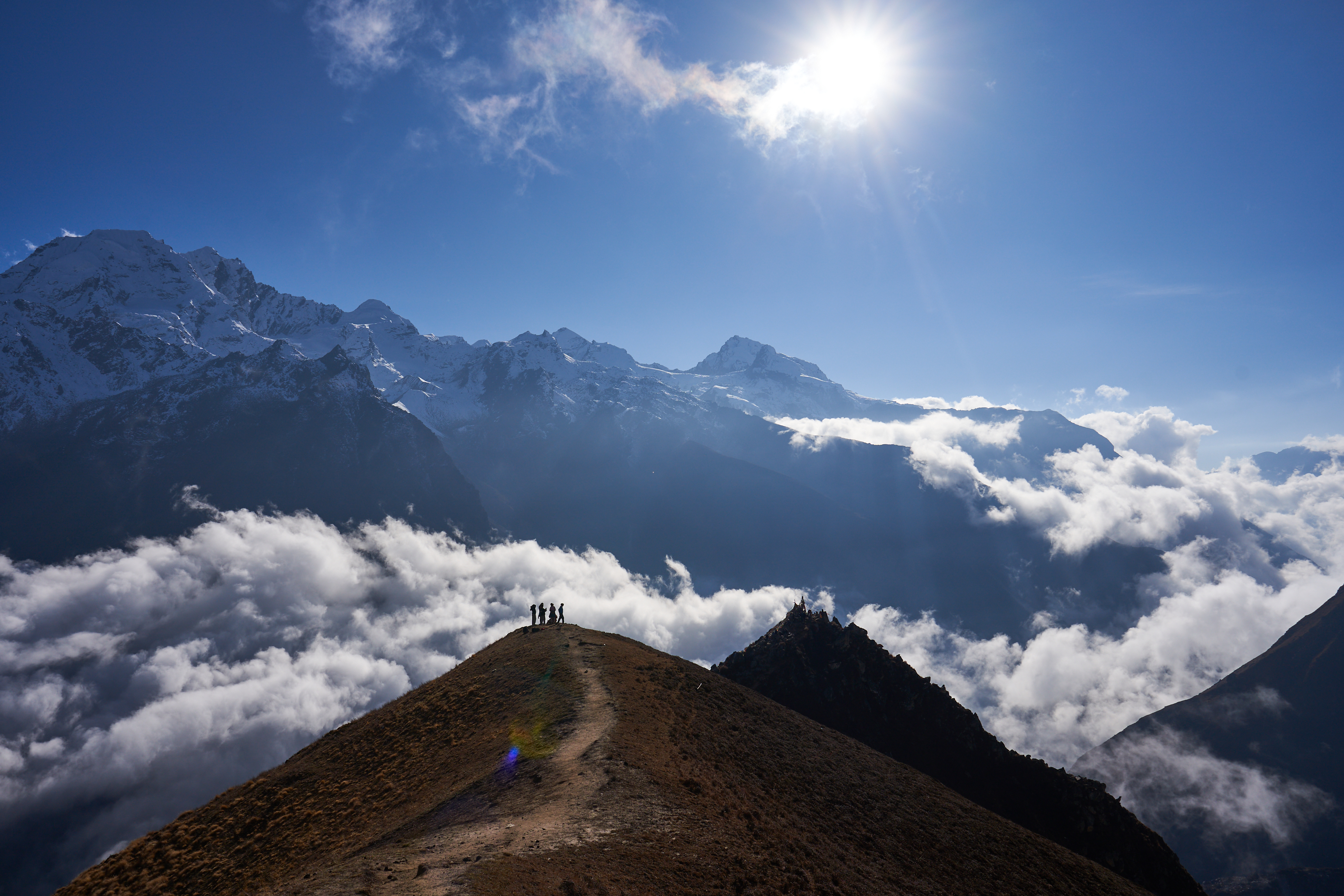
Best Alternative Treks Around the Langtang Valley
While the Langtang Valley Trek is one of the most popular trekking routes in Nepal, the Langtang region offers several equally stunning alternative treks for those seeking more variety and adventure. These alternative treks provide an opportunity to explore remote villages, sacred lakes, and hidden passes, all while enjoying the breathtaking beauty of the Himalayas. Here are some of the best alternative treks around the Langtang Valley that you can consider for your next adventure:
1. Ganjala Pass Trek
The Ganjala Pass Trek is one of the most challenging treks in the Langtang region. It takes trekkers over the high Ganjala Pass, which reaches 5,130 meters. The trek offers spectacular views of the Langtang Lirung and Ganesh Himal peaks. This adventure is perfect for those seeking a tougher route with fewer crowds. You’ll pass through remote areas, crossing rocky terrain and staying in traditional villages. The views, especially from the pass, are breathtaking and well worth the effort.
2. Tamang Heritage Trail
The Tamang Heritage Trail offers a cultural immersion like no other. This moderate trek takes you through charming Tamang villages and allows you to experience their rich cultural heritage. You’ll hike through lush forests, passing ancient monasteries, and have the chance to interact with the Tamang people. The trek offers panoramic views of Langtang and Ganesh Himal. This is an excellent option for those who want to explore rural life in Nepal while enjoying beautiful mountain scenery.
3. Pangsang Pass with Ruby Valley Trek
The Pangsang Pass with Ruby Valley Trek is a combination of beautiful landscapes and cultural exploration. The trek includes a challenging crossing of the Pangsang Pass at 3,800 meters. Along the way, you’ll witness panoramic views of the Annapurna and Ganesh Himal ranges. This route also takes you through the Ruby Valley, a less-traveled area known for its ruby mining and ethnic Tamang villages. It’s a great choice for trekkers looking to avoid crowded trails and explore a region with rich cultural and geological significance.
4. Helambu Circuit Trek
The Helambu Circuit Trek is a short but scenic option that’s ideal for trekkers looking for a moderate challenge. This trek takes you through picturesque Sherpa villages and dense forests. You’ll be rewarded with stunning views of the Langtang Himal and Jugal Himal ranges. The trek is relatively low in altitude, making it suitable for those looking for a less strenuous hike. It’s an excellent opportunity to explore Sherpa culture and enjoy the natural beauty of the region without venturing too high into the mountains.
5. Gosainkunda Lake Trek
The Gosainkunda Lake Trek is one of Nepal’s most spiritual treks. The trek takes you to the holy Gosainkunda Lake, which sits at 4,380 meters in the Langtang National Park. This lake is an important pilgrimage site for both Hindus and Buddhists, especially during the full moon festival. The trek features beautiful alpine scenery, with lush forests, rugged mountain passes, and pristine lakes. Along the way, you’ll experience the serenity of the high-altitude environment, making it a spiritual and scenic journey all in one.
Customize Your Itinerary
Each of these alternative treks offers a unique experience, whether you're interested in culture, challenging hikes, or breathtaking views. If you're thinking about combining one of these treks with the Langtang Valley Trek or crafting a completely customized adventure, we can help design an itinerary that fits your interests, fitness level, and schedule. Get in touch with us to plan your perfect trek in the Langtang region for the 2026/27 season.

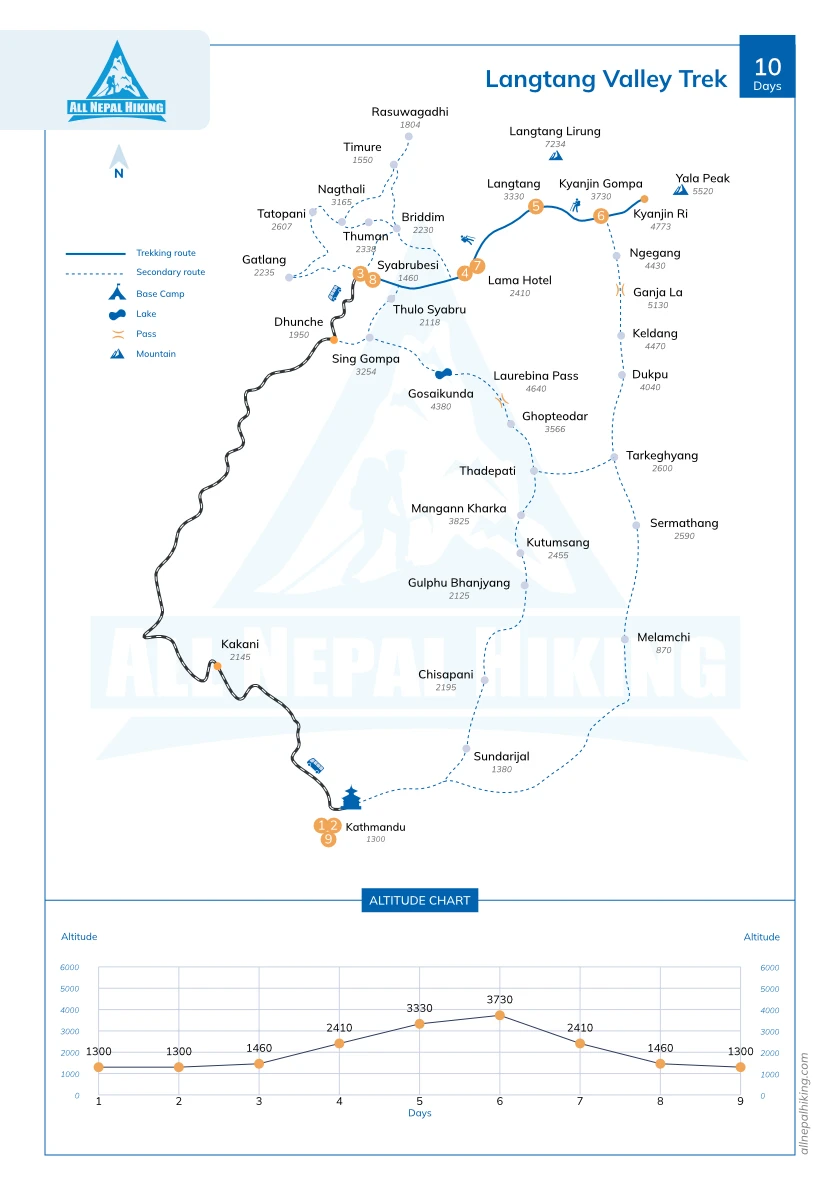

 based on 1 review
based on 1 review